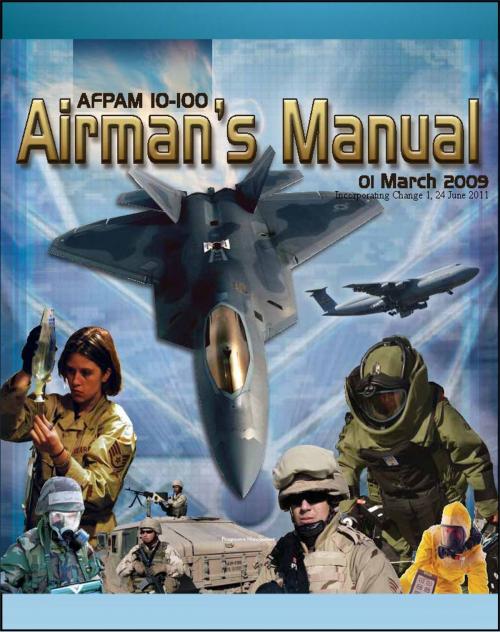21st Century U.S. Military Manuals: U.S. Air Force Airman's Manual - Survival Skills, NBC Protective Equipment, IEDs, Terrorism, Security, Weapons, Staying Ready, Convoy Procedures
Nonfiction, History, Military, Biological & Chemical Warfare| Author: | Progressive Management | ISBN: | 9781465947376 |
| Publisher: | Progressive Management | Publication: | February 23, 2012 |
| Imprint: | Smashwords Edition | Language: | English |
| Author: | Progressive Management |
| ISBN: | 9781465947376 |
| Publisher: | Progressive Management |
| Publication: | February 23, 2012 |
| Imprint: | Smashwords Edition |
| Language: | English |
This highly informative quick reference guide - updated through 2011 - provides essential information for Air Force active duty, Air Force Reserve, Air National Guard, emergency essential civilians and contract personnel. The introduction states:
An Introduction for Airmen - As an expeditionary Airman you must stay ready to deploy anywhere in the world on short notice. This manual doesn't contain everything you must know. It doesn't focus on the integrated joint or multinational nature of combat operations. It doesn't replace regulations or local procedures you'll need to follow. This manual does, however, cover basic warfighting skills and points of knowledge with the intent to help you successfully complete the mission. The tasks outlined in this manual apply at both deployed and home station locations. Keep the Airman's Manual close to you; use it while training and exercising for contingencies and deployments. Refer to it often... you'll need it.
Sections in the document include: Staying ready; deploy; employment; fight; survive. Topics covered include: Survival skills, protective equipment for chemical, nuclear, and biological warfare; MOPP; weapons; protection against improvised explosive devices (IEDs); Force Protection Condition (FPCON);
terrorism; alarm conditions (green, yellow, red, black); security; convoy procedures; small arms - M4, M9, M16, M16AZ rifle, MCU-2, m45, and M50 masks; UXO; M291 AND M295 skin decontamination kits, health concerns during deployment; resources protection and crime prevention; personal anti-terrorism force protection actions; quick reference, and much more.
Attack Warning Signals for Chemical, Biological, Radiological, Nuclear, and high-yield Explosives in High Threat Areas - Standardized attack warning signals are used to posture airbases for attacks, warn of attacks in progress, initiate post-attack recovery actions, and return the airbases to a wartime state of readiness. Although warning signals are primarily designed to provide air, missile, artillery, and ground attack warning, they may also be used to warn you if a covert attack with a chemical, biological, or radiological weapon is discovered. Alarm warning signal variations might be used in some geographic regions. If they are, you'll be notified what those variations are before you depart your home station or when you arrive in that region. For example, Alarm Blue is used instead of Alarm Red in South Korea. Alarm Blue will be announced and blue flags will be displayed.
Many foreign countries have environments that you have to experience to fully understand. Medical threats from heat, cold, water, food, disease, poor sanitation, and pollutants are real. Remember, in the history of warfare, more people are lost to disease than to combat.
This highly informative quick reference guide - updated through 2011 - provides essential information for Air Force active duty, Air Force Reserve, Air National Guard, emergency essential civilians and contract personnel. The introduction states:
An Introduction for Airmen - As an expeditionary Airman you must stay ready to deploy anywhere in the world on short notice. This manual doesn't contain everything you must know. It doesn't focus on the integrated joint or multinational nature of combat operations. It doesn't replace regulations or local procedures you'll need to follow. This manual does, however, cover basic warfighting skills and points of knowledge with the intent to help you successfully complete the mission. The tasks outlined in this manual apply at both deployed and home station locations. Keep the Airman's Manual close to you; use it while training and exercising for contingencies and deployments. Refer to it often... you'll need it.
Sections in the document include: Staying ready; deploy; employment; fight; survive. Topics covered include: Survival skills, protective equipment for chemical, nuclear, and biological warfare; MOPP; weapons; protection against improvised explosive devices (IEDs); Force Protection Condition (FPCON);
terrorism; alarm conditions (green, yellow, red, black); security; convoy procedures; small arms - M4, M9, M16, M16AZ rifle, MCU-2, m45, and M50 masks; UXO; M291 AND M295 skin decontamination kits, health concerns during deployment; resources protection and crime prevention; personal anti-terrorism force protection actions; quick reference, and much more.
Attack Warning Signals for Chemical, Biological, Radiological, Nuclear, and high-yield Explosives in High Threat Areas - Standardized attack warning signals are used to posture airbases for attacks, warn of attacks in progress, initiate post-attack recovery actions, and return the airbases to a wartime state of readiness. Although warning signals are primarily designed to provide air, missile, artillery, and ground attack warning, they may also be used to warn you if a covert attack with a chemical, biological, or radiological weapon is discovered. Alarm warning signal variations might be used in some geographic regions. If they are, you'll be notified what those variations are before you depart your home station or when you arrive in that region. For example, Alarm Blue is used instead of Alarm Red in South Korea. Alarm Blue will be announced and blue flags will be displayed.
Many foreign countries have environments that you have to experience to fully understand. Medical threats from heat, cold, water, food, disease, poor sanitation, and pollutants are real. Remember, in the history of warfare, more people are lost to disease than to combat.















